Comments
Re: Physoplexis comosa
A fine example of Physoplexis comosa exhibited at the AGS Southport Show in May this year ... my own large plant is very late this year and is probably still two weeks away from optimum flowering, I will try to remember to post an image when it finally blooms.
Here is a link to my best plant last year ...
http://www.alpinegardensociety.net/competitions/online-show/2010/Campanu...
Re: Physoplexis comosa
Cliff - that is such a fascinating plant! The only time I ever grew it well was in a block of tufa but a friend in our group now has a specimen about half the size of yours. Some of its meadow relatives (Phyteuma spp.) are equally intriguing in a strange way. How old is that plant?
Re: Physoplexis comosa
Cliff - that is such a fascinating plant! The only time I ever grew it well was in a block of tufa but a friend in our group now has a specimen about half the size of yours. Some of its meadow relatives (Phyteuma spp.) are equally intriguing in a strange way. How old is that plant?
Hi Tim,
I cannot be certain, but I think it's at least seven years old. Labels fade and disappear and I have a jumbled and eclectic mix of plants that perfectly reflects my decaying brain and fading memory. I now grow at least six physoplexis of varying sizes and ages and they all survive our cool, wet winters outside without any protection. I give the big plants a chicken mesh 'cap' to protect them from the attentions of the blackbirds, but that is the only mollycoddling that they enjoy.
We have seen some splendid examples in the Dolomites, but rarely do they display more than three or four blooms in the wild.
Re: Physoplexis comosa
Cliff, how do you manage them after they bloom? Do you keep them growing, or dry them off and let them go dormant? If they are growing outdoors for you, I guess they get water all summer, true? I lose a few every year, but I don't know why. I do know that they don't like dry potting mix in winter.
Re: Physoplexis comosa
This plant is so interesting that I don't think it is possible to take an unworthy photo of Physoplexis. ;D
Re: Physoplexis comosa
Cliff, how do you manage them after they bloom? Do you keep them growing, or dry them off and let them go dormant? If they are growing outdoors for you, I guess they get water all summer, true? I lose a few every year, but I don't know why. I do know that they don't like dry potting mix in winter.
Hi Gene,
All my plants (even the first year seedlings) stay outside all winter and experience everything that a cool, damp Lancashire winter can throw at them - this can see torrential rain, hard frosts, snow, sun and fog - often in the same week!
After flowering can see spells of hot sun, heavy showers and warm drying winds, the physoplexis experiences all these conditions in the Dolomites and the necessary constants are excellent drainage and a calcareous compost. These plants produce an extensive root system so a deep pot is essential and I use a 12" pan full of a very gritty limestone mix. I never feed my plants and always let them die back naturally whatever the conditions. Hope this helps, but I realise just how different our growing conditions must be?
Re: Physoplexis comosa
Absolutely beautiful, Cliff! You must be so pleased to grow them so well!
Re: Physoplexis comosa
They are stunning - and to have a whole flat of seedlings? Oh boy, I best order some seeds. Or perhaps, try to get one at Hole's Greenhouse in St. Albert, Alberta.... 'Tis true, I don't think there could be a bad photo of Physoplexis comosa...
Re: Physoplexis comosa
If you want to grow them from seed, check out the Spring 2009 NARGS bulletin. There is an article in which I tell everything I know about starting them from seed. It took me many tries to be successful. I believe it was because I kept getting dead seed. If anyone wants to try some seed, let me know. I may have a fresh crop this fall.
Re: Physoplexis comosa
If you want to grow them from seed, check out the Spring 2009 NARGS bulletin. There is an article in which I tell everything I know about starting them from seed. It took me many tries to be successful. I believe it was because I kept getting dead seed. If anyone wants to try some seed, let me know. I may have a fresh crop this fall.
Yes please :D I have tried Physoplexis but never got germination. I saw pictures in Thompson & Morgan's catalogue many, many years ago and have ever since wanted to grow it!
However I grow the close relative Phyteuma. Not the same though but nice growable plants. (And it is raining again today :-\ )
Re: Physoplexis comosa
Lovely images Trond.
I have just posted this one on AlpenPix ... Phyteuma sieberi from the Dolomites. One of the smallest and perfect for troughs/mini-gardens.
Re: Physoplexis comosa
Chris, I can't get the link to work; can you repost it.
Re: Physoplexis comosa
Mark, for some unknown reason Hugh and I ran into the same problem, try updating to the latest version of Adobe Reader, it worked for us.
Re: Physoplexis comosa
An additional image or two to illustrate the barren open aspect where they grow and a plant showing immature blooms ... on the expansive limestone cliffs and boulders at Falzerego in the Dolomites.
Re: Physoplexis comosa
Gene's articles on starting Physoplexis and Gentianopsis from seed may also be found on the Wiki Encyclopedia in the Plants by Genus section under the appropriate genus names.
Re: Physoplexis comosa
An additional image or two to illustrate the barren open aspect where they grow and a plant showing immature blooms ... on the expansive limestone cliffs and boulders at Falzerego in the Dolomites.
Hmm, that looks not totally unlike parts of my tufa garden... perhaps there is hope!
Re: Physoplexis comosa
An additional image or two to illustrate the barren open aspect where they grow and a plant showing immature blooms ... on the expansive limestone cliffs and boulders at Falzerego in the Dolomites.
Hmm, that looks not totally unlike parts of my tufa garden... perhaps there is hope!
I knew you had a great garden!
Re: Physoplexis comosa
An additional image or two to illustrate the barren open aspect where they grow and a plant showing immature blooms ... on the expansive limestone cliffs and boulders at Falzerego in the Dolomites.
Hmm, that looks not totally unlike parts of my tufa garden... perhaps there is hope!
I knew you had a great garden!
I just meant the close-up, not the background!! ;D
Re: Physoplexis comosa
An additional image or two to illustrate the barren open aspect where they grow and a plant showing immature blooms ... on the expansive limestone cliffs and boulders at Falzerego in the Dolomites.
Hmm, that looks not totally unlike parts of my tufa garden... perhaps there is hope!
I knew you had a great garden!
I just meant the close-up, not the background!! ;D
Oh, don't be modest ;D ;D
Re: Physoplexis comosa
I planted them out on a raised bed of sandy loam soil, late last summer. Some I planted under the shelter of rocks, and some went directly into the raised bed. Most are emerging now. So far, they do not seem to be very picky. But you do have to control the slugs and snails. Photos to come if/when they bloom.
Re: Physoplexis comosa
I took a couple of photos today of Physoplexis comosa. The first one in a pot has elongated flower stems. The second in a sand bed with lumps of tufa is growing much tighter and is altogether more satisfying. Fortunately the slugs haven't found it yet. ;D
Re: Physoplexis comosa
I'm sure most of us are very jealous, David - about either form! And what an interesting effect with the sun dancing on all the stigmas of the flowers in the first pic... It's like each flower bunch is setting off their own fireworks display!!! :o
Re: Physoplexis comosa
Rick:
I like photographing flowers backlit by the sun as it often enhances the flower colour and creates interesting effects particularly as flowers are translucent. But I have to admit the fireworks were quite a surprise. I didn't notice it when taking the photograph.
Re: Physoplexis comosa
This is such a great plant - nothing quite like it, even all the weird and wonderful phyteumas. I would love to get this going in tufa - we were lucky enough to visit Robin and Sue White (Blackthorn Nursery) and Peter Erskine a week or two ago before these had started flowering, but both, particularly Peter, had specimens everywhere in tufa and narrow crevices. Once you find the spot to grow a plant...
Re: Physoplexis comosa
Here is a sturdy little plant growing in the open ground, on a raised bed of sandy loam:
The bee is interested, but I doubt that it can pollinate the flowers. The style is too far away.
I planted out roughly 20 plants last Fall, and only one has failed to appear this Spring.
Re: Physoplexis comosa
Wow! Fantastic, David and Gene!
Re: Physoplexis comosa
Checking in on my garden-grown P. comosa today: here is about one third of the group:
[attachthumb=1]
Sorry about the white flowers all over my garden from the black locust trees.
A nice specimen:
[attachthumb=2]
Seasonal transitions are long drawn-out affairs in the Pacific NW. So the blooming season is very spread out, and gives less spectacular photo opportunities. Here is a plant with a spent bloom (center), a fresh bloom (left), and a new bud (right):
[attachthumb=3]
They are in a raised bed of sandy loam soil. No special protection; lots of sunshine; occasional water in Summer; I apply some dolomite lime once per year, plus a little NPK fertilizer.
I've got about 50 new plants in the greenhouse. If anybody wants them, you are welcome to them. But you would have to come and get them. I don't have time to pack and ship. If you want more than one or two, I'm sure we can work something out. 8)
Spectacular!
Spectacular!
I have managed to grow
I have managed to grow Physoplexis from seed from the NARGS seedex a few years ago. They remain outdoors and have bloomed nicely for the past two seasons. Looking for advice on how best to collect seed as I would like to contribute some to the exchage.
There is nothing easy about
There is nothing easy about this. In my climate, they make little green seedpods that remain on the plant all summer long. Then they are gone. I suspect the birds eat them. I suggest that you protect the plants with bird netting or an inverted nursery flat, to keep the birds away. Pull a seed pod off occasionally and see if it has ripe seed in it.



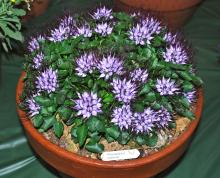
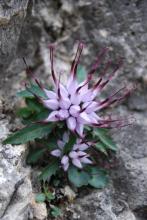
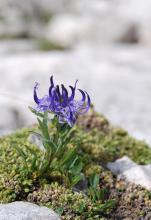
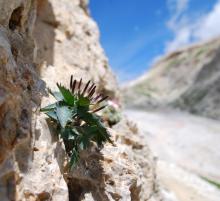
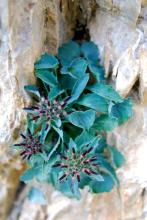

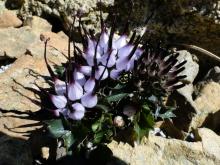
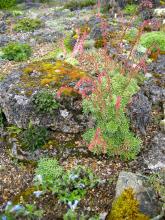
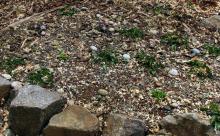
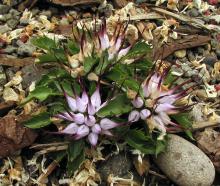
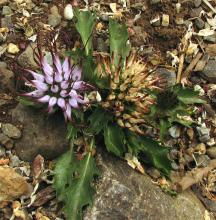
What a beautifully-grown tray of gems there! When you do plant them out, will they go in troughs or a rock garden? What conditions do they favour? (I've only killed them so far. :P )